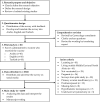Menstrual Symptoms After COVID-19 Vaccine: A Cross-Sectional Investigation in the MENA Region
- PMID: 35378876
- PMCID: PMC8976114
- DOI: 10.2147/IJWH.S352167
Menstrual Symptoms After COVID-19 Vaccine: A Cross-Sectional Investigation in the MENA Region
Abstract
Background: Since the emergence of COVID-19 vaccinations, many women around the world are reporting abnormalities in their menstrual periods post-vaccination. The aim of this study is to investigate the prevalence and impact of menstrual abnormalities after the COVID-19 vaccine among females residing within the Middle East and North Africa (MENA).
Methods: The study utilized a cross-sectional online self-administered survey from July 2021 to August 2021 targeting females living in the MENA region above the age of menarche who had received vaccine and were not pregnant or lactating, and do not have a history of primary ovarian insufficiency, hypothalamic menopause, or have undergone a hysterectomy. The survey was distributed regionally via social media.
Results: A total of 2269 females were included in our study, with a mean age of 34.3 ± 8.5 years. About 66.3% of participants reported menstrual symptoms post-vaccination, of which 46.7% experienced them after their first dose. However, in 93.6% of participants, the symptoms resolved within 2 months. Vaccine type did not significantly influence the incidence of abnormalities (p > 0.05). Participants who had confirmed previous COVID-19 infection had a very similar percentage of menstrual abnormalities compared to people who did not have COVID-19 infection or symptoms suspected of COVID-19 infection and did not test (67.5%, 66.8%, respectively); nevertheless, those who had experienced the COVID-19 vaccine general side effects had significantly more abnormalities (p < 0.001). Compared to their pandemic status, females reported significantly more abnormalities post-vaccination.
Conclusion: The study showed a possible link between the COVID-19 vaccine and menstrual abnormalities that have impacted their quality of life.
Keywords: COVID-19; MENA; menstrual abnormalities; menstrual cycle; vaccine.
© 2022 Muhaidat et al.
Conflict of interest statement
The authors declare that they have no known competing financial or personal interests that could have influenced the work reported in this paper.
Figures
References
-
- Centers for Disease Control and Prevention. V-safe after vaccination health checker. Available from: https://www.cdc.gov/coronavirus/2019-ncov/vaccines/safety/vsafe.html. Accessed August 27, 2021.
LinkOut - more resources
Full Text Sources
Research Materials



